A Comparative Study of the Thermal Conductivities of CBA Porous Concretes
Abstract
:1. Introduction
2. Experimental Details
2.1. CBA Aggregate and Cement
2.2. Mixtures
2.3. Casting and Curing Conditions
2.4. Testing Methods
3. Results and Discussion
3.1. Unit Weight
3.2. Total Void Ratio
3.3. Thermal Conductivity
3.4. Scanning Electron Microscope (SEM) Analysis
4. Relationships among Test Results
4.1. Relationship between Unit Weight and Porosity
4.2. Relationship between Thermal Conductivity and Unit Weight
4.3. Relationship between Thermal Conductivity and Total Void Ratio
5. Conclusions
- The unit weight of CBA porous concrete was slightly affected by the water/cement ratio. An increase in the water/cement ratio from 0.25 to 0.35 led to decreases in the unit weight of the porous concrete ranging from 3.0 to 5.0%. Moreover, the compaction level significantly increased the unit weight of the CBA porous concrete by 5.0 to 15.0%. In addition, the statistical results indicated that the compaction levels had different influences on each mixture.
- The test results revealed that the total void ratio of the CBA porous concrete increased as the water/cement ratio increased, but this increase was not significant. However, the increases in the total void ratios of CBA porous concrete ranged between 7.0% and 17.0% with the increasing compaction level. It was also observed that the compaction dramatically reduced the porosity of the concrete. Statistical analysis was also carried out and revealed the statistically significant differences between the results.
- Regarding the effect of the water/cement ratio on the thermal conductivity of the CBA porous concrete, the thermal conductivity was significantly reduced by increases in the water/cement ratio. The thermal conductivity of the CBA porous concrete decreased by 4% to 16% as the water/cement ratio was increased from 0.25 to 0.35.
- The test results also revealed that the thermal conductivity of the CBA porous concrete decreased by 0.2% to 9.6% with increases in the compaction level. This implied that the thermal insulation of the CBA porous concrete was not significantly affected by the compaction levels used in this study, but the other properties were significantly improved.
- Finally, the relationships between the thermal conductivity and the mechanical properties of the porous concrete were estimated. By using the relationship curves, the tendency of thermal conductivity relating to the unit weight and total void ratios could be determined.
Author Contributions
Funding
Institutional Review Board Statement
Informed Consent Statement
Data Availability Statement
Conflicts of Interest
References
- ACI Committee 522. Report on Pervious Concrete; American Concrete Institute: Farmington Hills, MI, USA, 2010. [Google Scholar]
- Bhutta, M.A.R.; Tsuruta, K.; Mirza, J. Evaluation of High-Performance Porous Concrete Properties. Constr. Build. Mater. 2012, 31, 67–73. [Google Scholar] [CrossRef]
- Huang, B.; Wu, H.; Shu, X.; Burdette, E.G. Laboratory Evaluation of Permeability and Strength of Polymer-Modified Pervious Concrete. Constr. Build. Mater. 2010, 24, 818–823. [Google Scholar] [CrossRef]
- Abbas, S.; Arshad, U.; Abbass, W.; Nehdi, M.L.; Ahmed, A. Recycling Untreated Coal Bottom Ash with Added Value for Mitigating Alkali–Silica Reaction in Concrete: A Sustainable Approach. Sustainability 2020, 12, 10631. [Google Scholar] [CrossRef]
- Kim, H.-K. Coal Bottom Ash. In Sustainable Concrete Made with Ashes and Dust from Different Sources; Elsevier: Amsterdam, The Netherlands, 2022; pp. 29–60. [Google Scholar] [CrossRef]
- Zhou, H.; Bhattarai, R.; Li, Y.; Si, B.; Dong, X.; Wang, T.; Yao, Z. Towards Sustainable Coal Industry: Turning Coal Bottom Ash into Wealth. Sci. Total. Environ. 2022, 804, 149985. [Google Scholar] [CrossRef]
- Muthusamy, K.; Rasid, M.H.; Jokhio, G.A.; Mokhtar Albshir Budiea, A.; Hussin, M.W.; Mirza, J. Coal Bottom Ash as Sand Replacement in Concrete: A Review. Constr. Build. Mater. 2020, 236, 117507. [Google Scholar] [CrossRef]
- Zaetang, Y.; Wongsa, A.; Sata, V.; Chindaprasirt, P. Use of Lightweight Aggregates in Pervious Concrete. Constr. Build. Mater. 2013, 48, 585–591. [Google Scholar] [CrossRef]
- Gooi, S.; Mousa, A.A.; Kong, D. A Critical Review and Gap Analysis on the Use of Coal Bottom Ash as a Substitute Constituent in Concrete. J. Clean. Prod. 2020, 268, 121752. [Google Scholar] [CrossRef]
- Park, J.-H.; Bui, Q.-T.; Jung, S.-H.; Yang, I.-H. Selected Strength Properties of Coal Bottom Ash (CBA) Concrete Containing Fly Ash under Different Curing and Drying Conditions. Materials 2021, 14, 5381. [Google Scholar] [CrossRef]
- Singh, N.; Shehnazdeep; Bhardwaj, A. Reviewing the Role of Coal Bottom Ash as an Alternative of Cement. Constr. Build. Mater. 2020, 233, 117276. [Google Scholar] [CrossRef]
- Singh, M.; Siddique, R. Compressive Strength, Drying Shrinkage and Chemical Resistance of Concrete Incorporating Coal Bottom Ash as Partial or Total Replacement of Sand. Constr. Build. Mater. 2014, 68, 39–48. [Google Scholar] [CrossRef]
- Kim, H.K.; Lee, H.K. Use of Power Plant Bottom Ash as Fine and Coarse Aggregates in High-Strength Concrete. Constr. Build. Mater. 2011, 25, 1115–1122. [Google Scholar] [CrossRef]
- Zhou, H.; Brooks, A.L. Thermal and Mechanical Properties of Structural Lightweight Concrete Containing Lightweight Aggregates and Fly-Ash Cenospheres. Constr. Build. Mater. 2019, 198, 512–526. [Google Scholar] [CrossRef]
- Yang, I.-H.; Park, J. A Study on the Thermal Properties of High-Strength Concrete Containing CBA Fine Aggregates. Materials 2020, 13, 1493. [Google Scholar] [CrossRef] [Green Version]
- Ngohpok, C.; Sata, V.; Satiennam, T.; Klungboonkrong, P.; Chindaprasirt, P. Mechanical Properties, Thermal Conductivity, and Sound Absorption of Pervious Concrete Containing Recycled Concrete and Bottom Ash Aggregates. KSCE J. Civ. Eng. 2018, 22, 1369–1376. [Google Scholar] [CrossRef]
- Jang, J.G.; Ahn, Y.B.; Souri, H.; Lee, H.K. A Novel Eco-Friendly Porous Concrete Fabricated with Coal Ash and Geopolymeric Binder: Heavy Metal Leaching Characteristics and Compressive Strength. Constr. Build. Mater. 2015, 79, 173–181. [Google Scholar] [CrossRef]
- Huang, J.; Luo, Z.; Khan, M.B.E. Impact of Aggregate Type and Size and Mineral Admixtures on the Properties of Pervious Concrete: An Experimental Investigation. Constr. Build. Mater. 2020, 265, 120759. [Google Scholar] [CrossRef]
- Kováč, M.; Sičáková, A. Pervious Concrete as an Environmental Solution for Pavements: Focus on Key Properties. Environments. 2018, 5, 11. [Google Scholar] [CrossRef] [Green Version]
- Li, L.G.; Feng, J.J.; Lu, Z.C.; Xie, H.Z.; Xiao, B.F.; Kwan, A.K.H.; Jiao, C.J. Effects of Aggregate Bulking and Film Thicknesses on Water Permeability and Strength of Pervious Concrete. Powder Technol. 2022, 396, 743–753. [Google Scholar] [CrossRef]
- Bonicelli, A.; Giustozzi, F.; Crispino, M. Experimental Study on the Effects of Fine Sand Addition on Differentially Compacted Pervious Concrete. Constr. Build. Mater. 2015, 91, 102–110. [Google Scholar] [CrossRef]
- Schaefer, V.R.; Wang, K.; Suleiman, M.T.; Kevern, J.T. Mix Design Development for Pervious Concrete in Cold Weather Climates; Deptartment of Transportation, Highway Division: Ames, IA, USA, 2006. [Google Scholar]
- Tennnis, P.D.; Leming, M.L.; Akers, D.J. Pervious Concrete Pavements; Portland Cement Association: Silver Spring, MD, USA, 2004; ISBN 0-89312-242-4. [Google Scholar]
- Barnhouse, P.W.; Srubar, W.V. Material Characterization and Hydraulic Conductivity Modeling of Macroporous Recycled-Aggregate Pervious Concrete. Constr. Build. Mater. 2016, 110, 89–97. [Google Scholar] [CrossRef]
- Leal Filho, W.; Hunt, J.; Lingos, A.; Platje, J.; Vieira, L.; Will, M.; Gavriletea, M. The Unsustainable Use of Sand: Reporting on a Global Problem. Sustainability 2021, 13, 3356. [Google Scholar] [CrossRef]
- Yang, I.-H.; Park, J.; Kim, K.-C.; Yoo, S.-W. A Comparative Study on the Thermal Conductivity of Concrete with Coal Bottom Ash under Different Drying Conditions. Adv. Civ. Eng. 2021, 2021, 1–12. [Google Scholar] [CrossRef]
- Debnath, B.; Sarkar, P.P. Permeability Prediction and Pore Structure Feature of Pervious Concrete Using Brick as Aggregate. Constr. Build. Mater. 2019, 213, 643–651. [Google Scholar] [CrossRef]
- KS F 2502; Standard Test Method for Sieve Test. Korea Industrial Standards: Seoul, Korea, 2006.
- KS F 2405; Standard Test Method for Compressive Strength of Concrete. Korea Industrial Standards: Seoul, Korea, 2010.
- ASTM D5334-05; Standard Test Method for Determination of Thermal Conductivity of Soil and Soft Rock by Thermal Needle Probe Procedure. ASTM: West Conshohocken, PA, USA, 2005.
- Log, T.; Gustafsson, S.E. Transient Plane Source (TPS) Technique for Measuring Thermal Transport Properties of Building Materials. Fire. Mater. 1995, 19, 43–49. [Google Scholar] [CrossRef]
- Gustafsson, S.E. Transient Plane Source Techniques for Thermal Conductivity and Thermal Diffusivity Measurements of Solid Materials. Rev. Sci. Instrum. 1991, 62, 797–804. [Google Scholar] [CrossRef]
- Li, Y.; Shi, C.; Liu, J.; Liu, E.; Shao, J.; Chen, Z.; Dorantes-Gonzalez, D.J.; Hu, X. Improving the Accuracy of the Transient Plane Source Method by Correcting Probe Heat Capacity and Resistance Influences. Meas. Sci. Technol. 2014, 25, 015006. [Google Scholar] [CrossRef]
- Zhang, W.; Min, H.; Gu, X.; Xi, Y.; Xing, Y. Mesoscale Model for Thermal Conductivity of Concrete. Constr. Build. Mater. 2015, 98, 8–16. [Google Scholar] [CrossRef]
- Nguyen, L.H.; Beaucour, A.-L.; Ortola, S.; Noumowé, A. Experimental Study on the Thermal Properties of Lightweight Aggregate Concretes at Different Moisture Contents and Ambient Temperatures. Constr. Build. Mater. 2017, 151, 720–731. [Google Scholar] [CrossRef]
- Kim, K.-H.; Jeon, S.-E.; Kim, J.-K.; Yang, S. An Experimental Study on Thermal Conductivity of Concrete. Cem. Concr. Res. 2003, 33, 363–371. [Google Scholar] [CrossRef]
- Jansson, R. Measurement of Concrete Thermal Properties at High Temperature. In Proceedings of the Task Group 4.3 Workshop “Fire Design of Concrete Structures: What Now? What Next?”, Milan, Italy, 2 December 2004; pp. 1–11. [Google Scholar]
- Pereira da Costa, F.B.; Haselbach, L.M.; da Silva Filho, L.C.P. Pervious Concrete for Desired Porosity: Influence of w/c Ratio and a Rheology-Modifying Admixture. Constr. Build. Mater. 2021, 268, 121084. [Google Scholar] [CrossRef]
- Banevičienė, V.; Malaiškienė, J.; Boris, R.; Zach, J. The Effect of Active Additives and Coarse Aggregate Granulometric Composition on the Properties and Durability of Pervious Concrete. Materials 2022, 15, 1035. [Google Scholar] [CrossRef] [PubMed]
- Cui, X.; Zhang, J.; Huang, D.; Liu, Z.; Hou, F.; Cui, S.; Zhang, L.; Wang, Z. Experimental Study on the Relationship between Permeability and Strength of Pervious Concrete. J. Mater. Civ. 2017, 29, 1–11. [Google Scholar] [CrossRef]
- Zhu, H.; Wen, C.; Wang, Z.; Li, L. Study on the Permeability of Recycled Aggregate Pervious Concrete with Fibers. Materials 2020, 13, 321. [Google Scholar] [CrossRef] [PubMed] [Green Version]
- Anthony, T.; Federico, A.; Cristian, G.; Parker, N.; Mario, C.; Collin, N. Developing High Strength Pervious Concrete Mixtures with Local Materials. J. Mater. Sci. Chem. Eng. 2020, 8, 20–34. [Google Scholar]
- Chen, J.; Wang, H.; Xie, P.; Najm, H. Analysis of Thermal Conductivity of Porous Concrete Using Laboratory Measurements and Microstructure Models. Constr. Build. Mater. 2019, 218, 90–98. [Google Scholar] [CrossRef]
- Chindaprasirt, P.; Nuaklong, P.; Zaetang, Y.; Sujumnongtokul, P.; Sata, V. Mechanical and Thermal Properties of Recycling Lightweight Pervious Concrete. Arab. J. Sci. Eng. 2015, 40, 443–450. [Google Scholar] [CrossRef]
- Torkittikul, P.; Nochaiya, T.; Wongkeo, W.; Chaipanich, A. Utilization of Coal Bottom Ash to Improve Thermal Insulation of Construction Material. J. Mater. Cycles Waste. Manag. 2017, 19, 305–317. [Google Scholar] [CrossRef]
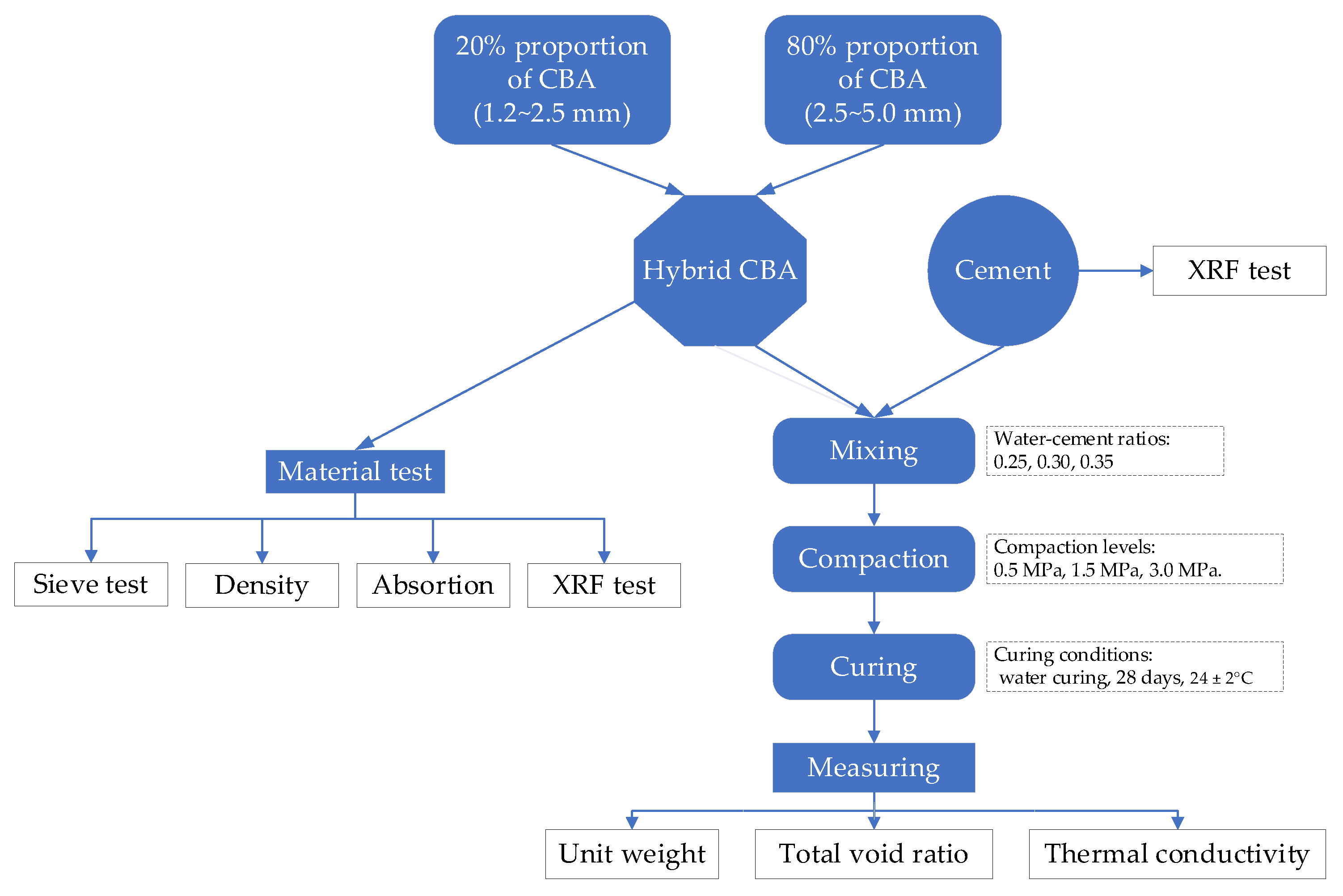
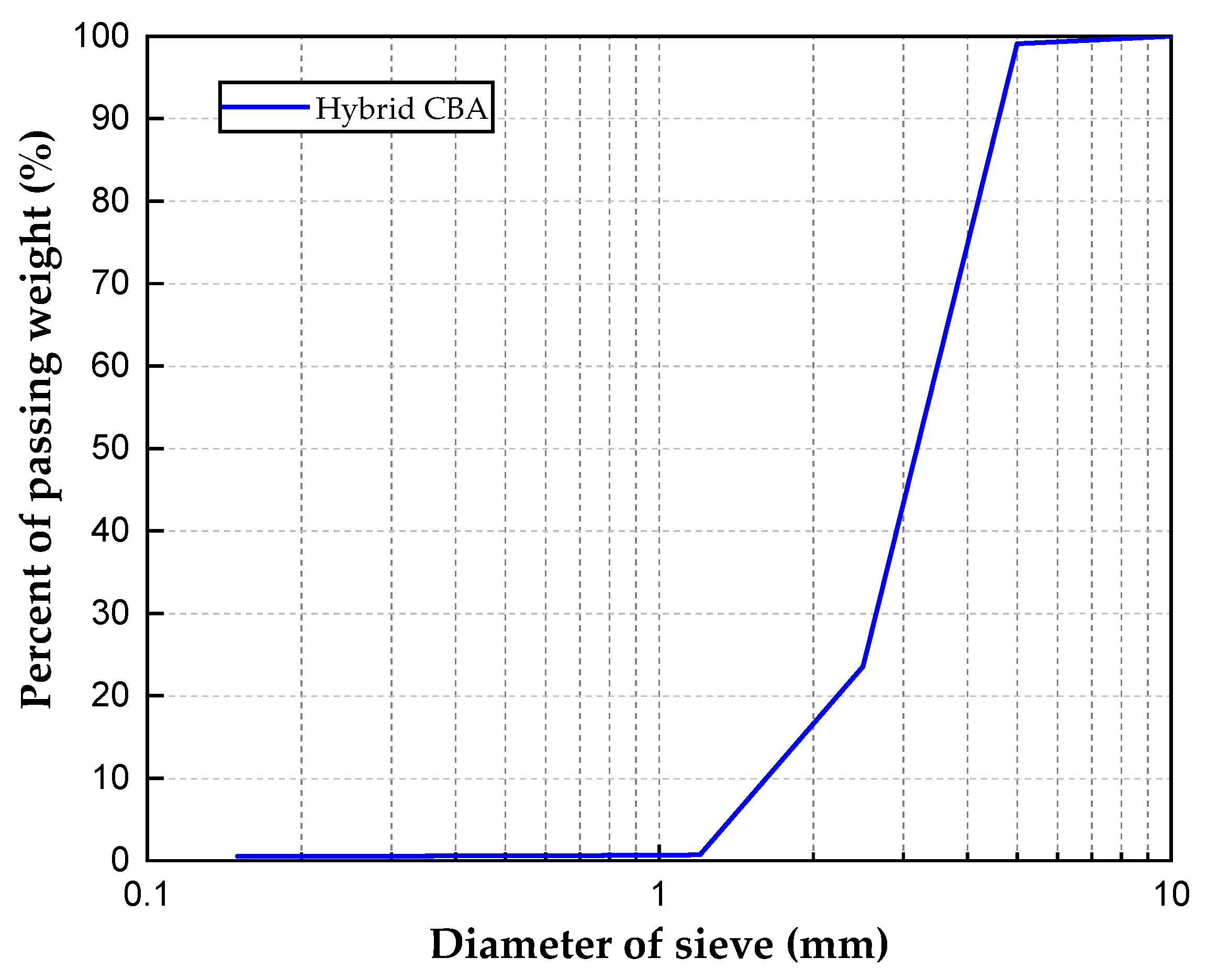

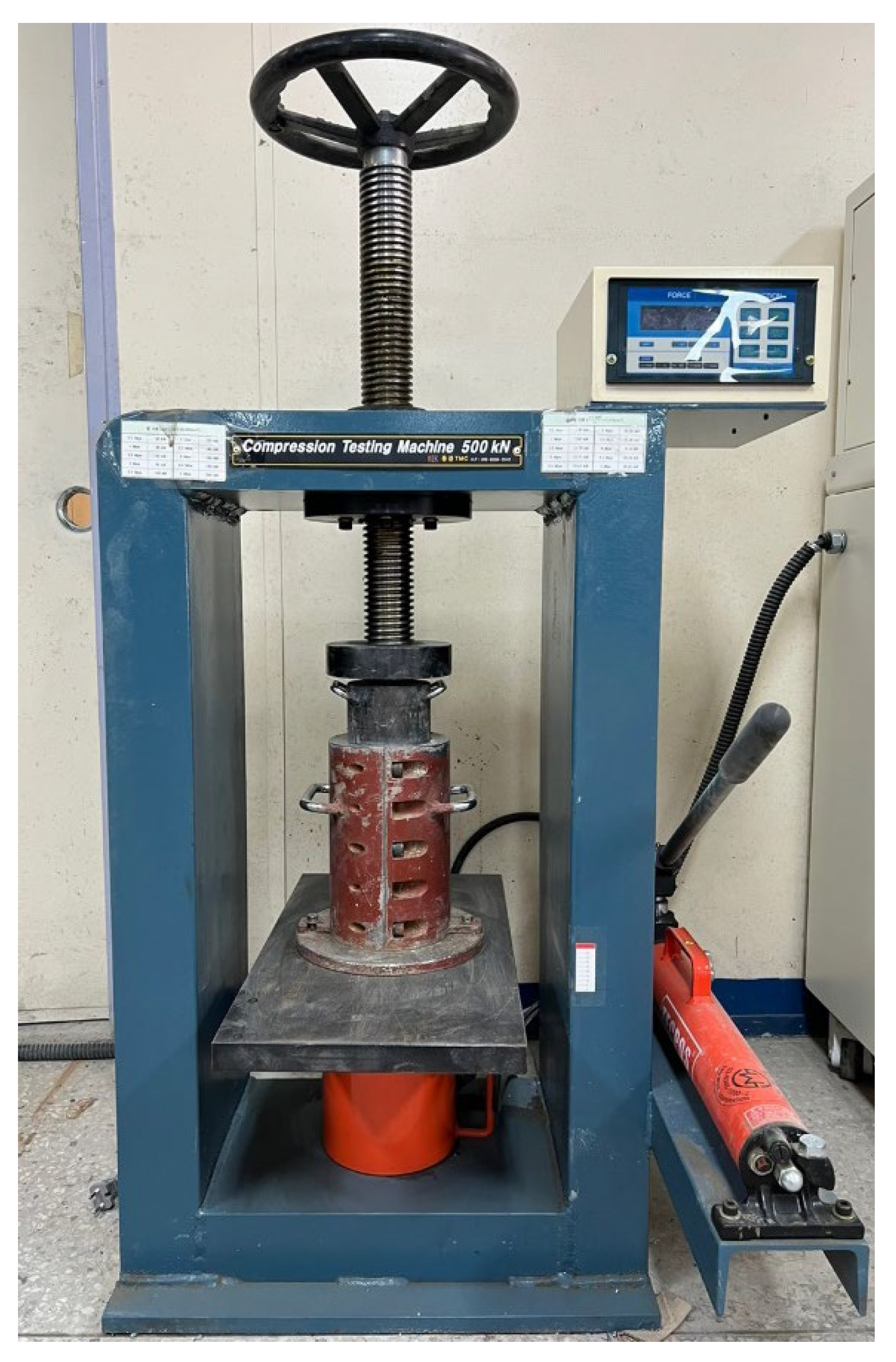
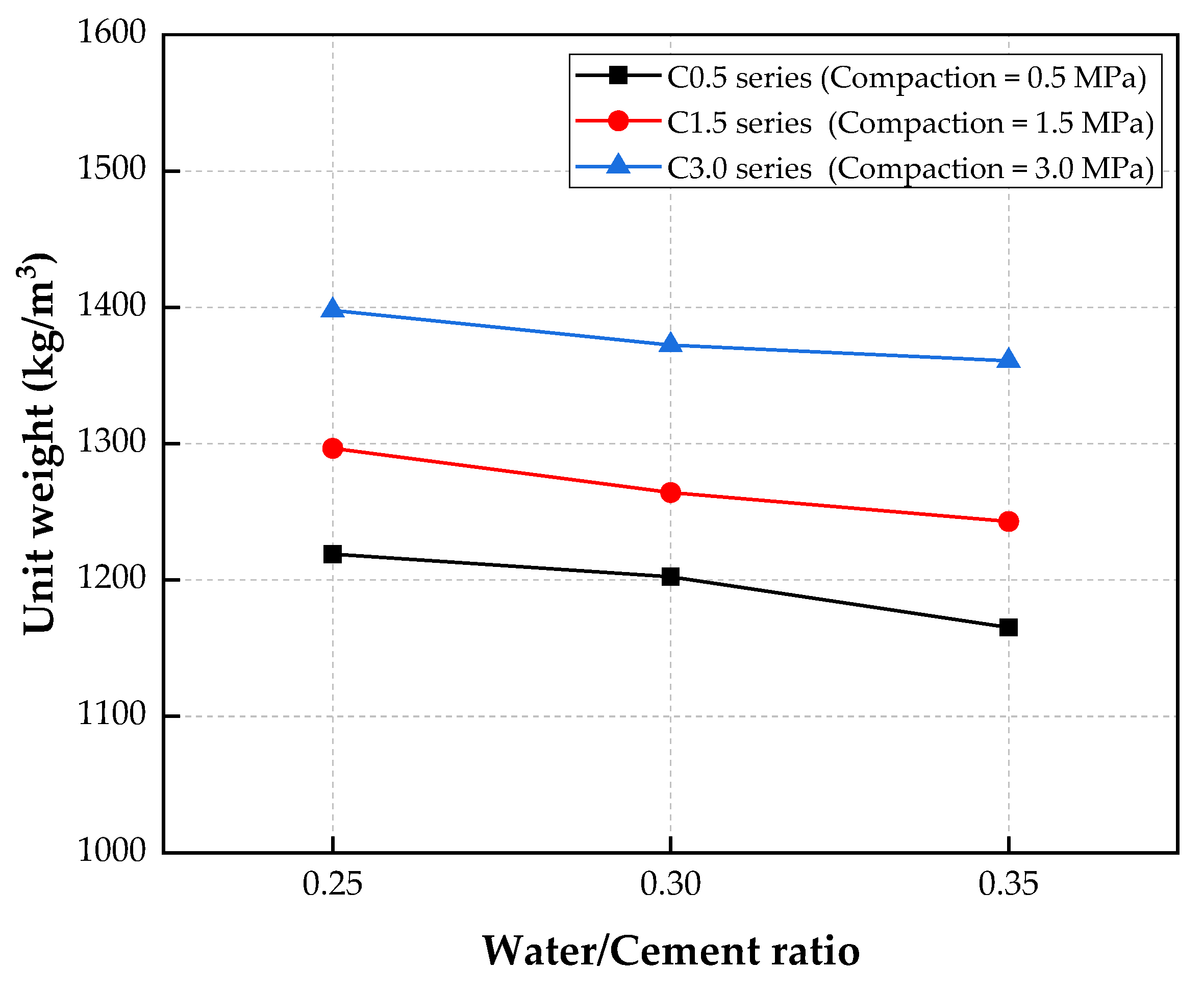
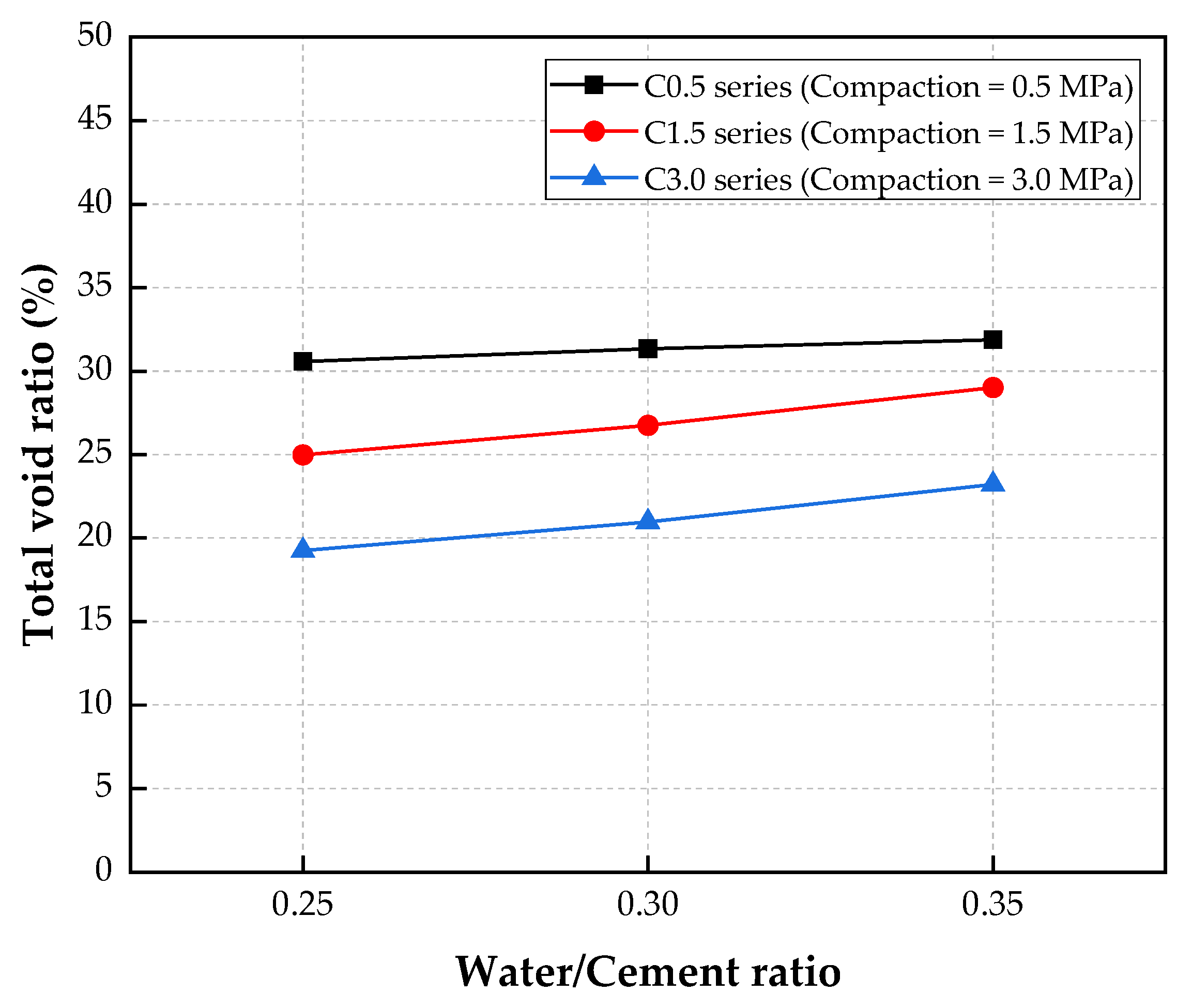
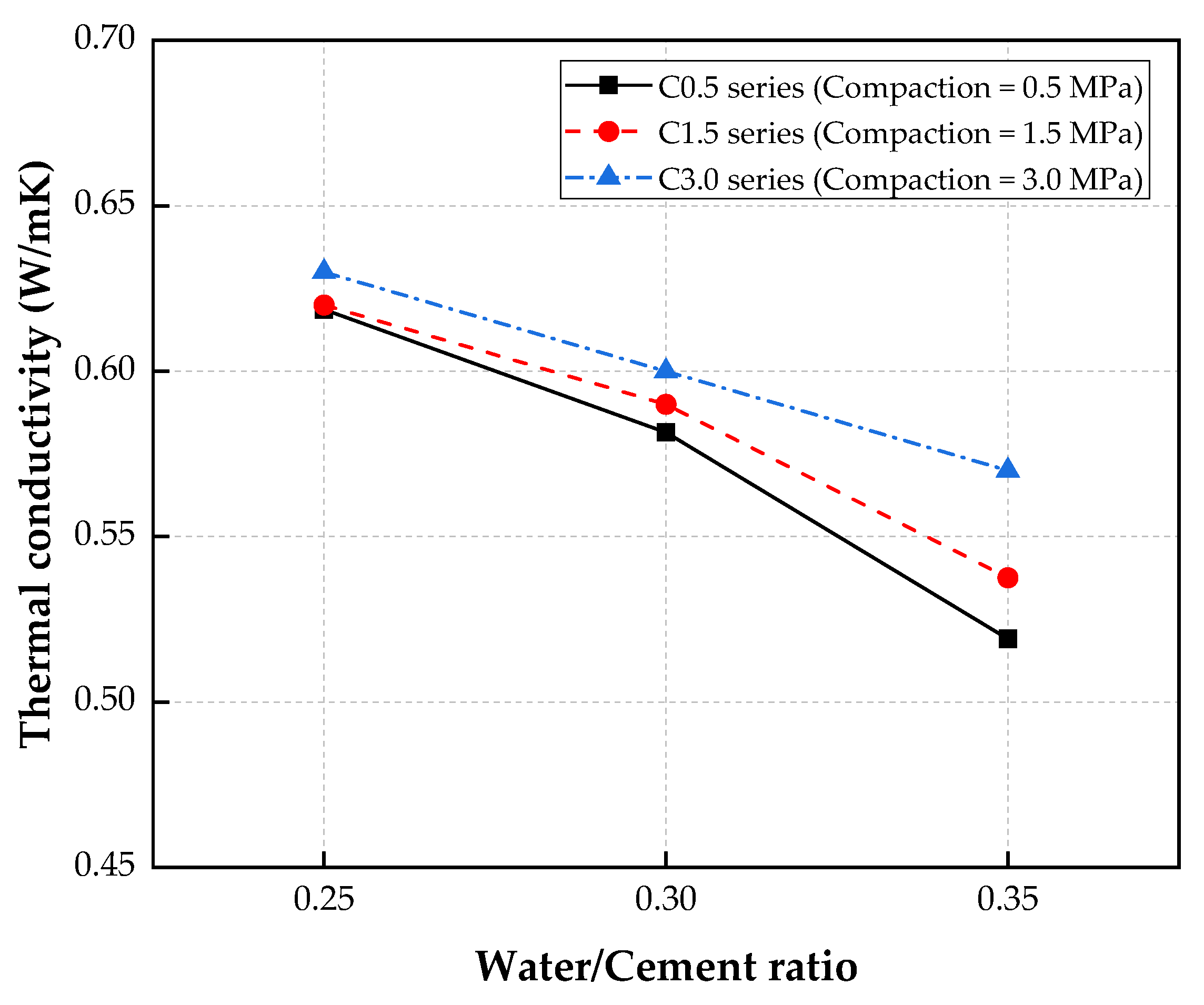

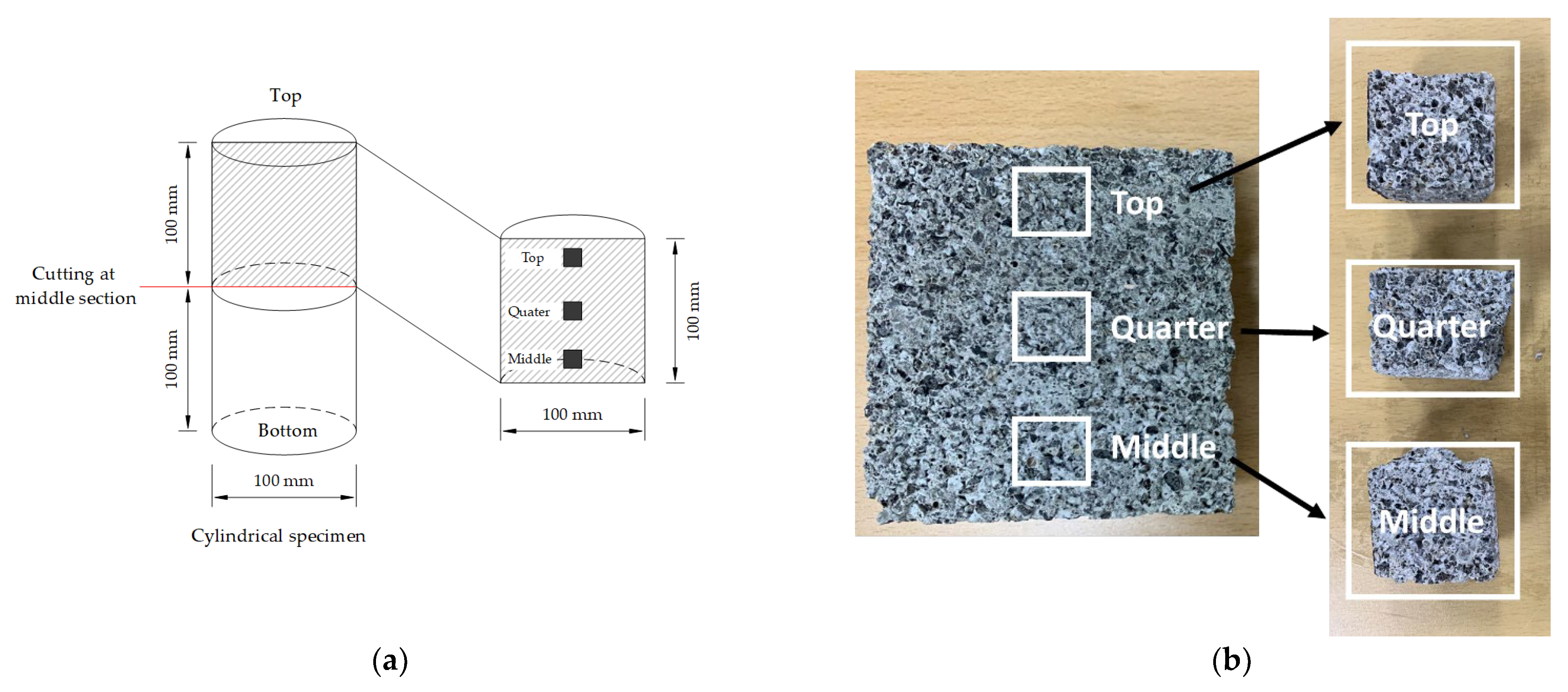

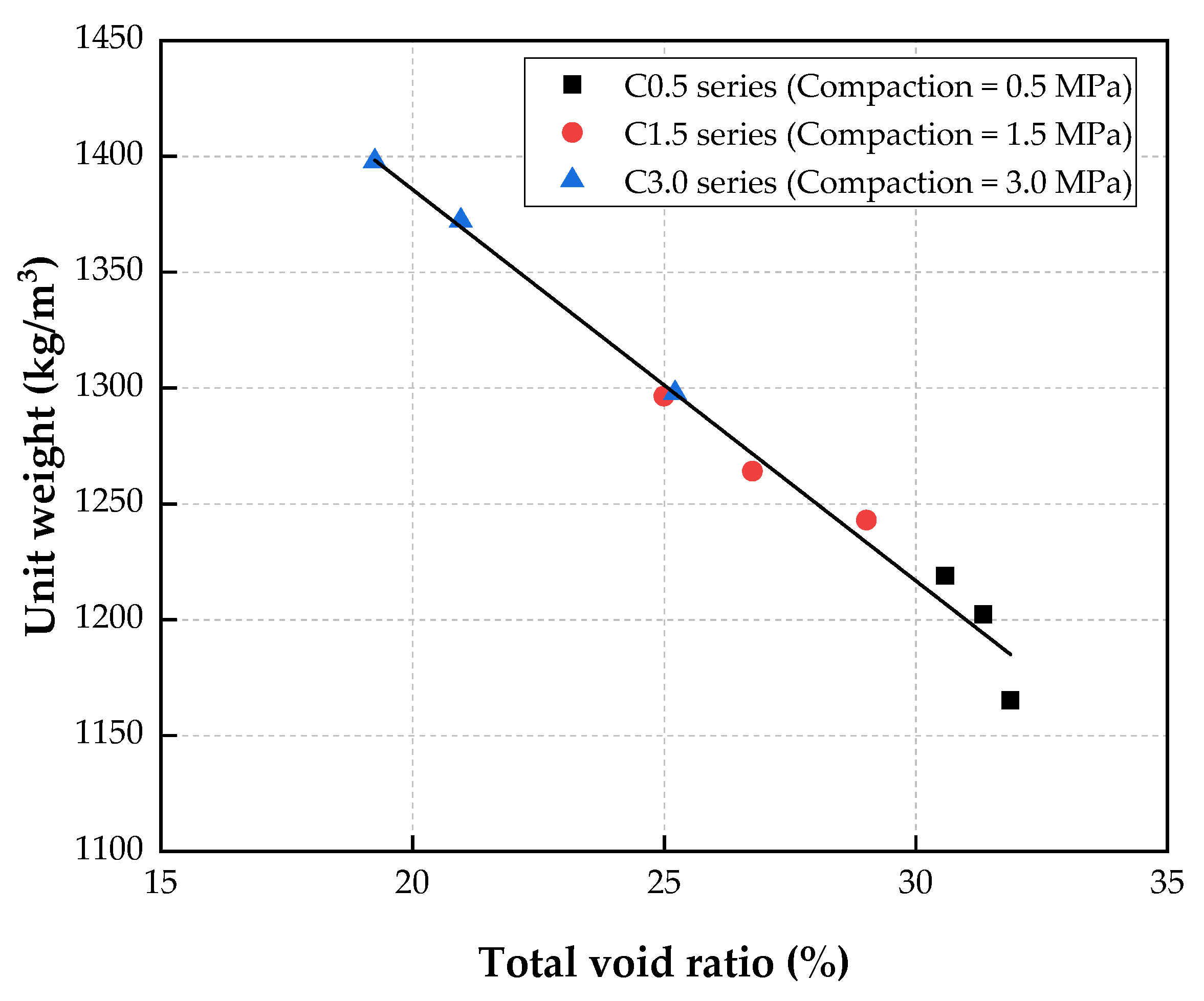

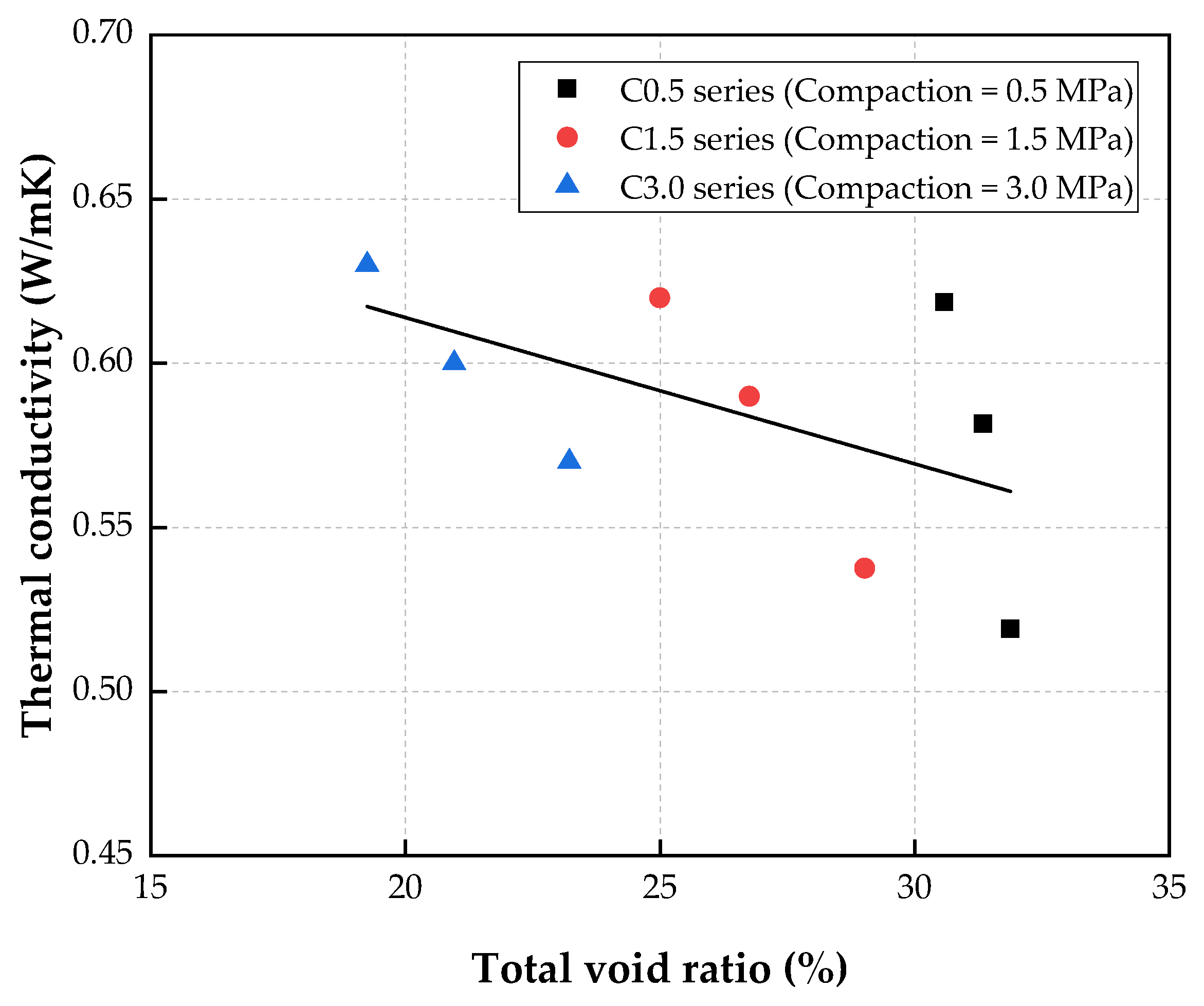
| Nominal Diameter | Remaining Weight | Remaining Ratio | Cumulative Remaining Ratio | Passing Weight | Passing Ratio |
|---|---|---|---|---|---|
| (mm) | (g) | (%) | (%) | (g) | (%) |
| 10.0 | 0.00 | 0.00 | 0.00 | 249.05 | 100.00 |
| 5.0 | 2.29 | 0.92 | 0.92 | 246.76 | 99.08 |
| 2.5 | 188.03 | 75.50 | 76.42 | 58.73 | 23.58 |
| 1.2 | 56.95 | 22.87 | 99.29 | 1.78 | 0.71 |
| 0.6 | 0.32 | 0.13 | 99.41 | 1.46 | 0.59 |
| 0.3 | 0.03 | 0.01 | 99.43 | 1.43 | 0.57 |
| 0.12 | 0.10 | 0.04 | 99.47 | 1.33 | 0.53 |
| pan | 1.33 | 0.53 | 100.00 | 0.00 | 0.00 |
| Total | 249.05 | 100 | Fineness modulus | 4.75 |
| Hybrid CBA Size | SSD Density | Oven-Dried Density | Absorption |
|---|---|---|---|
| (g/cm3) | (g/cm3) | (%) | |
| 2.5~5.0 mm (80%) + 1.2~2.5 mm (20%) | 1.73 | 1.61 | 7.75 |
| Component | CBA | OPC |
|---|---|---|
| (%) | (%) | |
| SiO2 | 55.75 | 17.65 |
| Al2O3 | 26.15 | 4.64 |
| Fe2O3 | 7.51 | 3.41 |
| CaO | 3.95 | 64.90 |
| Na2O | 0.73 | 0.21 |
| MgO | 1.12 | 3.51 |
| K2O | 1.19 | 1.15 |
| SO3 | 0.74 | 3.71 |
| LOI | 2.43 | 0.73 |
| No | Mixture | w/c Ratio | Unit Weight (kg/m3) | CA | Compaction | |||
|---|---|---|---|---|---|---|---|---|
| Water | OPC | CBA | MPa | |||||
| 1.2~2.5 mm | 2.5~5.0 mm | |||||||
| 1 | C0.5-W25 | 0.25 | 110.0 | 440.0 | 246.9 | 964.9 | 38.5 | 0.5 |
| 2 | C1.5-W25 | 110.0 | 440.0 | 246.9 | 964.9 | 38.5 | 1.5 | |
| 3 | C3.0-W25 | 110.0 | 440.0 | 246.9 | 964.9 | 38.5 | 3.0 | |
| 4 | C0.5-W30 | 0.30 | 110.0 | 366.7 | 255.0 | 996.7 | 38.5 | 0.5 |
| 5 | C1.5-W30 | 110.0 | 366.7 | 255.0 | 996.7 | 38.5 | 1.5 | |
| 6 | C3.0-W30 | 110.0 | 366.7 | 255.0 | 996.7 | 38.5 | 3.0 | |
| 7 | C0.5-W35 | 0.35 | 110.0 | 314.3 | 260.8 | 1019.5 | 38.5 | 0.5 |
| 8 | C1.5-W35 | 110.0 | 314.3 | 260.8 | 1019.5 | 38.5 | 1.5 | |
| 9 | C3.0-W35 | 110.0 | 314.3 | 260.8 | 1019.5 | 38.5 | 3.0 | |
| Mixture | Unit Weight | Total Void Ratio | Thermal Conductivity | |||
|---|---|---|---|---|---|---|
| (kg/m3) | (%) | (W/m∙K) | ||||
| Mean | S.D. | Mean | S.D. | Mean | S.D. | |
| C0.5-W25 | 1219 | 22 | 30.6 | 1.8 | 0.62 | 0.01 |
| C1.5-W25 | 1297 | 31 | 24.9 | 2.8 | 0.62 | 0.01 |
| C3.0-W25 | 1398 | 51 | 19.3 | 2.0 | 0.63 | 0.02 |
| C0.5-W30 | 1202 | 58 | 31.3 | 3.9 | 0.58 | 0.01 |
| C1.5-W30 | 1264 | 37 | 26.8 | 2.8 | 0.59 | 0.02 |
| C3.0-W30 | 1372 | 34 | 20.9 | 1.7 | 0.60 | 0.02 |
| C0.5-W35 | 1165 | 23 | 31.9 | 1.9 | 0.52 | 0.01 |
| C1.5-W35 | 1243 | 30 | 29.0 | 2.0 | 0.54 | 0.03 |
| C3.0-W35 | 1361 | 50 | 23.2 | 3.1 | 0.57 | 0.01 |
Publisher’s Note: MDPI stays neutral with regard to jurisdictional claims in published maps and institutional affiliations. |
© 2022 by the authors. Licensee MDPI, Basel, Switzerland. This article is an open access article distributed under the terms and conditions of the Creative Commons Attribution (CC BY) license (https://creativecommons.org/licenses/by/4.0/).
Share and Cite
Jeong, S.-T.; Bui, Q.-T.; Yang, I.-H. A Comparative Study of the Thermal Conductivities of CBA Porous Concretes. Materials 2022, 15, 5204. https://doi.org/10.3390/ma15155204
Jeong S-T, Bui Q-T, Yang I-H. A Comparative Study of the Thermal Conductivities of CBA Porous Concretes. Materials. 2022; 15(15):5204. https://doi.org/10.3390/ma15155204
Chicago/Turabian StyleJeong, Seung-Tae, Quang-The Bui, and In-Hwan Yang. 2022. "A Comparative Study of the Thermal Conductivities of CBA Porous Concretes" Materials 15, no. 15: 5204. https://doi.org/10.3390/ma15155204
APA StyleJeong, S.-T., Bui, Q.-T., & Yang, I.-H. (2022). A Comparative Study of the Thermal Conductivities of CBA Porous Concretes. Materials, 15(15), 5204. https://doi.org/10.3390/ma15155204






